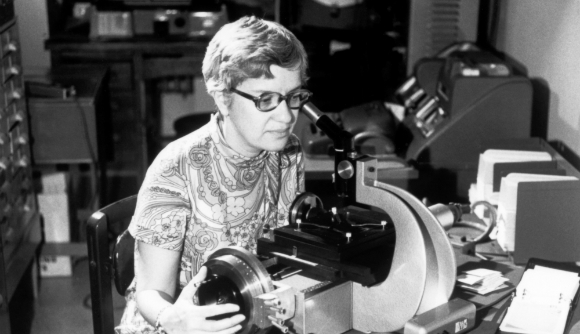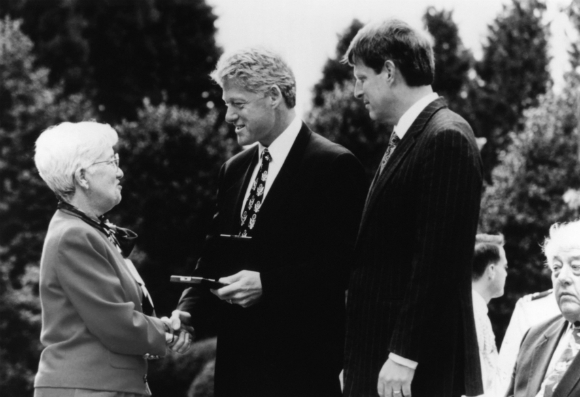Vera Rubin, a groundbreaking American astrophysicist who shed new light on the motion of galaxies and provided evidence for the existence of dark matter, has passed away
In our solar system, planets obey Kepler’s laws of planetary motion: the ones closer to the sun revolve around it at a higher velocity. Mercury revolves around the sun faster than Venus and Earth, which are faster than Mars, Jupiter, Saturn, etc.
However, in the 1970s, it was revealed that this is not the case everywhere. Observations on distant galaxies indicated that stars at a galaxy’s edges move faster than those closer to the center. As far as we know, in a whole galaxy, as in a single solar system, most of the mass is found at the center, so objects closer to the center of mass should move faster.
The researchers concluded that if indeed the outermost stars are moving faster, there must be invisible mass at the edges of these galaxies, which they termed “dark matter.” Behind this discovery stood an extraordinary groundbreaking female scientist, who passed away this week.
Galaxies off-route
Vera Cooper was born in Philadelphia in 1928. She was the second daughter of Philip Cooper, a Jewish electrical engineer from Lithuania, and Rose (Applebaum), an accountant in Bell Telephone Company. When Vera was 10 years old, the family moved to Washington DC. Interested in astronomy from a young age, she was encouraged and supported by her father. He took her to observations and lectures by non-professional astronomers, and even helped her build her first telescope when she was 14 years old.
Cooper earned her bachelor’s degree from Vassar College, which was one of the most prestigious all-women’s schools at the time. She graduated in 1948 and approached Princeton University for her graduate studies, but was rejected since the prestigious university did not accept women. Eventually, she was accepted to Cornell for graduate school, and trained with some of the most prominent physicists of her time. There she also met Robert Rubin, a graduate student in physical chemistry, and the two were married within a number of months.
In her master’s degree, Rubin studied the motion of galaxies. Years earlier, the world-renowned physicist Edwin Hubble showed that the universe is expanding, by measuring color changes in distant galaxies. When an object moves away from us at a very high velocity, the wavelengths of its colors will appear longer than they actually are, i.e., they will look more red, which is why the phenomena is called “redshift”. Examining these kind of measurements, Hubble found that the more distant the galaxy, the faster it is moving away from us. The conclusion was that all galaxies began at about the same place, and that our universe is constantly expanding.
Rubin delved into the data and found that many galaxies are not moving away from us in a straight line, as we would expect from the universe’s expansion, but also move to the “side” – that is, take a detour from the fast expansion path. The results of her research were not well received, and some leading journals refused to publish her paper.

Groundbreaking findings. Rubin measuring the spectra of galaxies in astronomical images | Photograph: Science Photo Library
The mystery of dark matter
Following her master’s degree, Rubin pursued a PhD in Georgetown University in Washington DC, under the supervision of George Gamow, one of the forefathers of the Big Bang Theory. She continued studying galaxies and their motion, and was one of the first to understand that galaxies are not randomly or evenly distributed through the universe, but rather, are concentrated in clusters. She finished her research in 1954, but this work also did not receive genuine recognition. Only in the 1970s, when more extensive research had been launched on very large celestial objects, Rubin’s insights were accepted by the scientific community.
After earning her PhD, she continued conducting research and teaching at Georgetown University for another decade and became a professor. Her research was focused on the motion of galaxies, including the rotation of star systems.
In 1965, she moved to Carnegie Institution of Washington, where she conducted her best-known research. Together with collaborator Kent Ford, she studied the motion of stars in the Milky Way’s small neighbor, Andromeda, in order to understand the manner by which mass is distributed in the galaxy. To their surprise, they found that stars at the outer part of the galaxy were moving at least as fast as the ones in the center.
Rubin and Ford examined a few dozen other galaxies, concluding that the phenomenon is a general one. The visible mass of the galaxy’s stars cannot explain the outer stars’ velocity, indicating the presence of additional mass, which we cannot see. The idea of dark matter had already been proposed in the 1930s, but Rubin and Ford’s work provided the first evidence for its existence. Nowadays, researchers estimate that 70-90% of the mass of the entire universe is dark matter. Many research institutes around the world are attempting to decipher the nature of dark matter, including CERN, the large European particle accelerator.

Rubin receives the National Medal of Science from President Bill Clinton, 1993 | Photograph: Science Photo Library
Asteroids and bathrooms
Rubin’s groundbreaking work was recognized by numerous scientific awards and honors, including the National Medal of Science (1993), the Gruber International Cosmology Prize (2002), and the Gold Medal of the Royal Astronomical Society (1996). An asteroid was named in her honor, and in recent years, she was mentioned several times as a candidate for the Nobel Prize in Physics. Dr. Emily Levesque, an astronomer at the University of Washington in Seattle said in an interview to Astronomy Magazine, “The existence of dark matter has utterly revolutionized our concept of the universe and our entire field; the ongoing effort to understand the role of dark matter has basically spawned entire subfields within astrophysics and particle physics at this point. Alfred Nobel’s will describes the physics prize as recognizing ‘the most important discovery’ within the field of physics. If dark matter doesn’t fit that description, I don’t know what does.”
In addition to her groundbreaking scientific work, Rubin worked to advance women in science, especially in astronomy. Among other things, she was the first woman to gain permission to operate the giant telescope at Palomar Observatory in California, which for many years was the largest and most important telescope in the United States. One of her colleagues said that there were no women’s bathrooms in the observatories, until Rubin took matters into her own hands, cutting a skirt shape out of a piece of paper and pasting it on the man’s stick figure in the observatory’s only bathroom. She was recognized for her activities in promoting women in science, and in 1996, was the second recipient of the Weizmann Women & Science Award, which the Weizmann Institute of Science awards to outstanding female scientists in the United States.
For many years, Rubin combined her work with raising four children. “I worked for almost all of my early career in part-time positions so that I could be home at 3 o'clock…I did a lot of my work at home”, said Rubin in a 2002 interview for Discover Magazine. She was successful in both aspects of her life: all four of her children hold a PhD in sciences – two sons are geologists, one is a mathematician, and her daughter followed in her mother’s footsteps and pursued a career in astronomy.
Rubin continued to work at the Carnegie Institution until retirement, and was involved in scientific research in her late years, until she became ill with dementia and could not continue working. She passed away at a retirement home in Princeton on December 25th 2016, not far from the university that refused to allow her to enroll – just because she was a woman. Carnegie president Matthew Scott paid tribute to Rubin following her death, saying she was “An accomplished astronomer and a wonderful role model for young scientists,” and emphasized that “Vera Rubin was a national treasure.”
Translated by Elee Shimshoni
